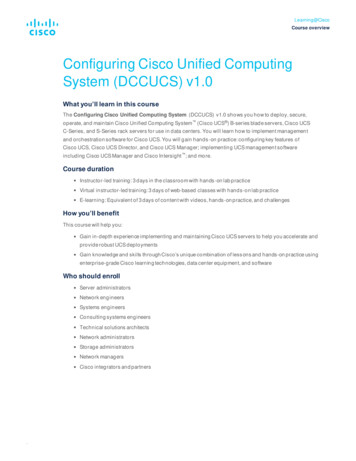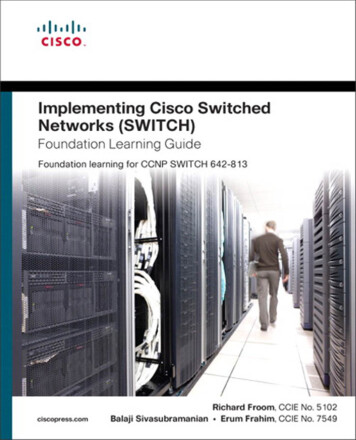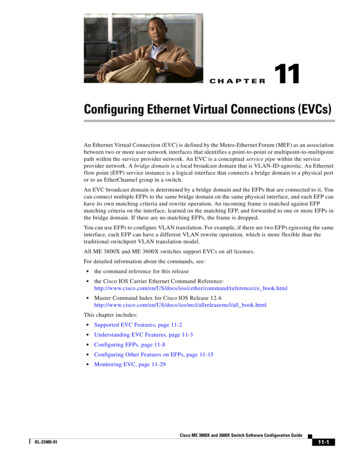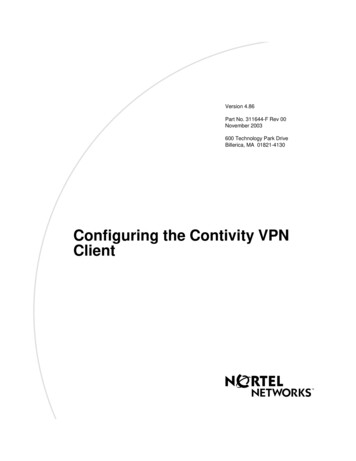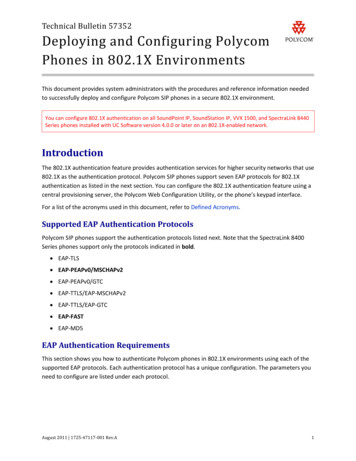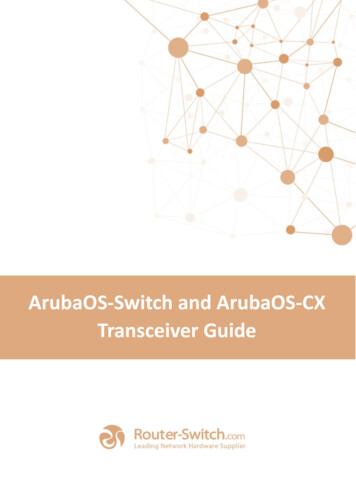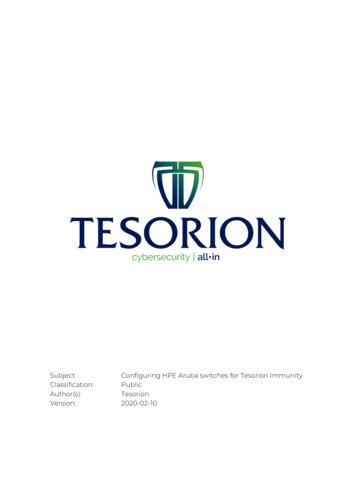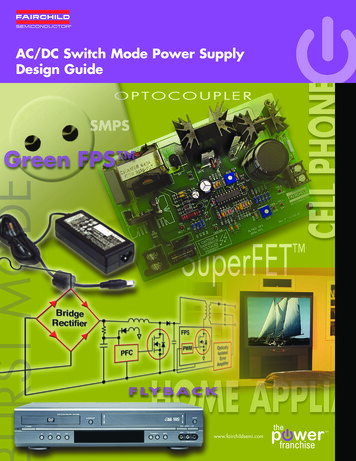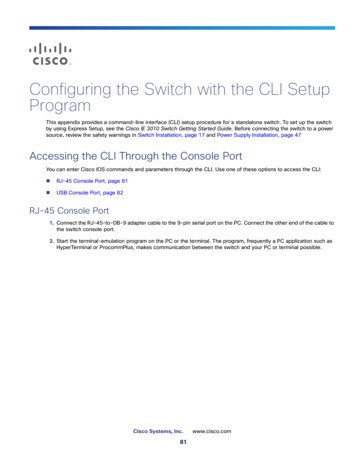
Transcription
Configuring the Switch with the CLI SetupProgramThis appendix provides a command-line interface (CLI) setup procedure for a standalone switch. To set up the switchby using Express Setup, see the Cisco IE 3010 Switch Getting Started Guide. Before connecting the switch to a powersource, review the safety warnings in Switch Installation, page 17 and Power Supply Installation, page 47Accessing the CLI Through the Console PortYou can enter Cisco IOS commands and parameters through the CLI. Use one of these options to access the CLI: RJ-45 Console Port, page 81 USB Console Port, page 82RJ-45 Console Port1. Connect the RJ-45-to-DB-9 adapter cable to the 9-pin serial port on the PC. Connect the other end of the cable tothe switch console port.2. Start the terminal-emulation program on the PC or the terminal. The program, frequently a PC application such asHyperTerminal or ProcommPlus, makes communication between the switch and your PC or terminal possible.Cisco Systems, Inc.81www.cisco.com
Configuring the Switch with the CLI Setup ProgramAccessing the CLI Through the Console PortFigure 64Connecting the Console Cable1C isco IE3010120838621RJ-45 console port2Console cable (RJ-45-to-DB-9 adaptercable)3. Configure the baud rate and character format of the PC or terminal to match the console port characteristics:—9600 baud—8 data bits—1 stop bit—No parity—None (flow control)4. Connect power to the switch as described in Power Supply Installation, page 475. The PC or terminal displays the bootloader sequence. Press Enter to display the setup prompt. Follow the steps inthe Completing the Setup Program, page 86.USB Console Port1. If you are connecting the switch USB console port to a Windows-based PC for the first time, install a USB driver. SeeFigure 65 on page 83. Installing the Cisco Microsoft Windows XP USB Driver, page 84 Installing the Cisco Microsoft Windows 2000 USB Driver, page 8482
Configuring the Switch with the CLI Setup ProgramAccessing the CLI Through the Console Port Installing the Cisco Microsoft Windows Vista USB Driver, page 85Figure 65Connecting the USB Console Cable1C isco IE23010131USB console port2USB cable32083792USB port on the PC2. Connect an USB cable to the PC USB port, and connect the other end of the cable to the switch mini-B(5-pin-connector) USB console port. See Figure 65 on page 83.3. To identify the COM port assigned to the USB console port:a. Choose Start Control Panel Systemsb. Click the Hardware tab and choose Device Manager.c. Expand the Ports section.The assigned COM port appears in parenthesis at the end of the line with this entry: Cisco USB System ManagementConsole.4. Start the terminal-emulation program on the PC or the terminal.The program, frequently a PC application such as HyperTerminal or ProcommPlus, makes communication possiblebetween the switch and your PC or terminal.5. Configure the COM port.6. Configure the baud rate and character format of the PC or terminal to match the console port characteristics:83
Configuring the Switch with the CLI Setup ProgramAccessing the CLI Through the Console Port—9600 baud—8 data bits—1 stop bit—No parity—None (flow control)7. Connect power to the switch as described in Power Supply Installation, page 47The PC or terminal displays the bootloader sequence.8. Press Enter to display the setup prompt.9. Follow the steps in the Completing the Setup Program, page 86.Installing the Cisco Microsoft Windows USB Device DriversInstalling the Cisco Microsoft Windows XP USB Driver1. Obtain the file Cisco usbconsole driver.zip from Cisco.com, and unzip it.Note: You can download the driver file from the Cisco.com software download site.—If using 32-bit Windows XP, double-click the setup.exe file in the Windows 32 folder.—If using 64-bit Windows XP, double-click the setup(x64).exe file in the Windows 64 folder.The Cisco Virtual Com InstallShield Wizard begins.The Ready to Install the Program window appears.2. Click Install.The InstallShield Wizard Completed window appears.3. Click Finish.4. Connect the USB cable to the PC and to the switch console port.The USB console port LED turns green, and the Found New Hardware Wizard appears.5. Follow the instructions to complete the driver installation.Installing the Cisco Microsoft Windows 2000 USB Driver1. Obtain the file Cisco usbconsole driver.zip from Cisco.com, and unzip it.Note: You can download the driver file from the Cisco.com software download site.2. Double-click the setup.exe file.The Cisco Virtual Com InstallShield Wizard begins.3. Click Next.The Ready to Install the Program window appears.84
Configuring the Switch with the CLI Setup ProgramAccessing the CLI Through the Console Port4. Click Install.The InstallShield Wizard Completed window appears.5. Click Finish.6. Connect the USB cable to the PC and to the switch console port.The USB console port LED turns green, and the Found New Hardware Wizard appears.7. Follow the instructions to complete the driver installation.Installing the Cisco Microsoft Windows Vista USB Driver1. Obtain the file Cisco usbconsole driver.zip from Cisco.com, and unzip it.Note: You can download the driver file from the Cisco.com software download site.2. Start the Cisco Virtual Com InstallShield Wizard:—If using 32-bit Windows Vista, double-click the setup.exe file in the Windows 32 folder.—If using 64-bit Windows Vista, double-click the setup(x64).exe file in the Windows 64 folder.The Cisco Virtual Com InstallShield Wizard begins.3. Click Next.The Ready to Install the Program window appears.4. Click Install.Note: If a User Account Control warning appears, click Allow - I trust this program.The InstallShield Wizard Completed window appears.5. Click Finish.6. Connect the USB cable to the PC and to the switch console port.The USB console port LED turns green, and the Found New Hardware Wizard appears.7. Follow the instructions to complete the driver installation.Uninstalling the Cisco Microsoft Windows USB DriversUninstalling the Cisco Microsoft Windows XP and 2000 USB DriverThe driver can be removed with the Windows Add or Remove Programs utility or with the setup.exe file.Using the Add or Remove Programs UtilityNote: Disconnect the switch console terminal before uninstalling the driver.1. Choose Start Control Panel Add or Remove Programs.2. Scroll to Cisco Virtual Com, and click Remove.3. When the Program Maintenance window appears, select the Remove radio button. Click Next.85
Configuring the Switch with the CLI Setup ProgramEntering the Initial Configuration InformationUsing the Setup.exe ProgramNote: Disconnect the switch console terminal before uninstalling the driver.1. Run setup.exe for Windows 32-bit or setup(x64).exe for Windows-64-bit. Click Next.2. The InstallShield Wizard for Cisco Virtual Com appears. Click Next.3. When the Program Maintenance window appears, select the Remove radio button. Click Next.4. When the Remove the Program window appears, click Remove.5. When the InstallShield Wizard Completed window appears, click Finish.Uninstalling the Cisco Microsoft Windows Vista USB DriverNote: Disconnect the switch console terminal before uninstalling the driver.1. Run setup.exe for Windows 32-bit or setup(x64).exe for Windows-64bit. Click Next.2. The InstallShield Wizard for Cisco Virtual Com appears. Click Next.3. When the Program Maintenance window appears, select the Remove radio button. Click Next.4. When the Remove the Program window appears, click Remove.Note: If a User Account Control warning appears, click Allow - I trust this program to proceed.5. When the InstallShield Wizard Completed window appears, click Finish.Entering the Initial Configuration InformationTo set up the switch, you need to complete the setup program, which runs automatically after the switch powers on. Youmust assign an IP address and other configuration information necessary for the switch to communicate with the localrouters and the Internet.IP SettingsYou need this information: Switch IP address Subnet mask (IP netmask) Default gateway (router) Enable secret password Enable password Telnet passwordCompleting the Setup ProgramFollow these steps to complete the setup program and to create an initial configuration for the switch:1. Enter Yes at the following prompts:Would you like to enter the initial configuration dialog? [yes/no]: yes86
Configuring the Switch with the CLI Setup ProgramEntering the Initial Configuration InformationAt any point you may enter a question mark '?' for help.Use ctrl-c to abort configuration dialog at any prompt.Default settings are in square brackets '[]'.Basic management setup configures only enough connectivityfor management of the system, extended setup will ask youto configure each interface on the system.Would you like to enter basic management setup? [yes/no]: yes2. Enter a host name for the switch, and press Return.On a command switch, the host name is limited to 28 characters and on a member switch to 31 characters. Do notuse -n, where n is a number, as the last character in a host name for any switch.Enter host name [Switch]: host name3. Enter an enable secret password, and press Return.The password can be from 1 to 25 alphanumeric characters, can start with a number, is case sensitive, allowsspaces, but ignores leading spaces. The secret password is encrypted, and the enable password is in plain text.Enter enable secret: secret password4. Enter an enable password, and press Return.Enter enable password: enable password5. Enter a virtual terminal (Telnet) password, and press Return.The password can be from 1 to 25 alphanumeric characters, is case sensitive, allows spaces, but ignores leadingspaces.Enter virtual terminal password: terminal-password6. (Optional) Configure Simple Network Management Protocol (SNMP) by responding to the prompts. You can alsoconfigure SNMP later through the CLI. To configure SNMP later, enter no.Configure SNMP Network Management? [no]: no7. Enter the interface name (physical interface or VLAN name) of the interface that connects to the managementnetwork, and press Return. For this release, always use vlan1 as that interface.Enter interface name used to connect to themanagement network from the above interface summary: vlan18. Configure the interface by entering the switch IP address and subnet mask and pressing Return. The IP address andsubnet masks shown below are examples.Configuring interface vlan1:Configure IP on this interface? [yes]: yesIP address for this interface: 10.4.120.106Subnet mask for this interface [255.0.0.0]: 255.0.0.0—Enter Y to configure the switch as the cluster command switch.—Enter N to configure it as a member switch or as a standalone switch.You can enter N to configure the switch as a command switch later through the CLI. To configure it later, enter no.Would you like to enable as a cluster command switch? [yes/no]: no87
Configuring the Switch with the CLI Setup ProgramEntering the Initial Configuration InformationYou have completed the initial configuration of the switch, and the switch displays its configuration. This is anexample of the configuration output:The following configuration command script was created:hostname switch1enable secret 5 1 Ulq8 DlA/OiaEbl90WcBPd9cOn1enable password enable passwordline vty 0 15password terminal-passwordno snmp-server!no ip routing!interface Vlan1no shutdownip address 10.4.120.106 255.0.0.0!interface FastEthernet1/0/1!interface FastEthernet1/0/2interface FastEthernet1/0/3!. output abbreviated endThese choices appear:[0] Go to the IOS command prompt without saving this config.[1] Return back to the setup without saving this config.[2] Save this configuration to nvram and exit.To save the configuration and use it the next time the switch reboots, select option 2 to save it in NVRAM.Enter your selection [2]:29. Make your selection, and press Return.After you complete the setup program, the switch can run the default configuration that you created. To change thisconfiguration or to perform other management tasks, enter commands at the Switch prompt.88
Enter a virtual terminal (Telnet) password, and press Return. The password can be from 1 to 25 alphanumeric characters, is case sensitive, allows spaces, but ignores leading spaces. Enter virtual terminal password: terminal-password 6. (Optional) Configure Simple Network Management P
